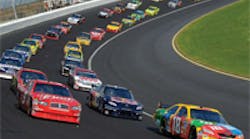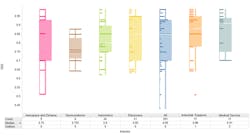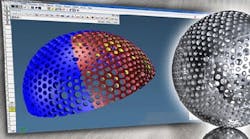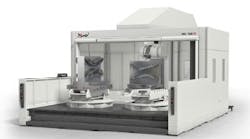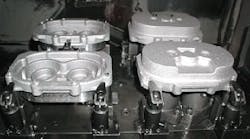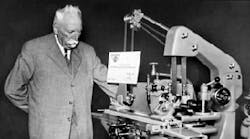On any given weekend between February and November, more than 75 million NASCAR fans watch their favorite auto racing teams compete for millions of dollars in prize money and even more millions from sponsorships and endorsements.
The cars are raced on oval tracks as short as the .54 mile track at Bristol, Tenn., and as long as the 2.7 mile track at Talladega, Ala.
On the shorter tracks, the straightaways keep top speeds down. However, on longer tracks, the engines are fitted with restrictor plates to hold the speeds down.
Under NASCAR rules, the car bodies are measured with templates to make sure they closely resemble the factory versions of the cars they represent, but there is more latitude when it comes to engine design, and so there is a constant effort to make improvements that will help to squeeze even more power and responsiveness from engines and drive trains that are already generating around 800 hp.
When NASCAR fans watch a race, they focus on the drivers and team managers.
They recognize that the race is not just a race, it is the high-speed automotive equivalent of a chess match where managing tire condition and fuel consumption are just as critical as who is behind the wheel when it comes to deciding who wins the race.
Drivers such as Kyle Busch, Jeff Burton, Dale Earnhardt Jr., Denny Hamlin, Clint Bowyer, Carl Edwards, Kevin Harvick, Tony Stewart, Jimmie Johnson and Jeff Gordon are well known to the fans of NASCAR. Even team managers, pit bosses and pit crews come under the watchful eyes, and often loud mouths, of the dedicated NASCAR fans. But what never seems to get acknowledged by commentators and fans alike is the absolutely critical role that machinists play in making sure every one of those cars is ready to run when it pulls out onto the track.
NASCAR racing is not just big business for the teams that compete, it is also big business for the companies that supply parts and equipment to those teams.
Even though the cars are made to resemble production automobiles, virtually every part on every car is custom made, especially all of the machined parts. Race teams spend millions of dollars every year to improve the performance of their cars, and this translates into millions of dollars in sales for the companies that supply those teams with the machines and tools used to make those improvements.
Companies that manufacture mills and lathes such as Doosan Infracore (http://domss.dhiac.com/), Haas Automation Inc. (www.haascnc.com), Mazak Corp. (www.mazakusa.com/) and Okuma America Corp. (www.okuma.com), EDM manufacturers such as Sodick Inc. (www.sodick.com), waterjet manufacturers such as Omax Corp. (www.omax.com) and Jet Edge (www.jetedge.com), software developers such as CNC Software, Inc., (www.mastercam.com) the maker of Mastercam software, Delcam (www.delcam.com) and Gibbs and Associates (www.gibbscam.com), the company that developed the GibbsCAM software package, and tool manufacturers such as Kennametal Inc. (www.kennametal.com) and Sandvik Coromant (www.coromant.sandvik.com/) have formed collaborations with racing teams to develop methods and machines that make the teams more competitive.
NASCAR teams look at every aspect of what they do, looking for ways to be more productive in the shop so that they can be more productive on the race track.
Even the software used to do shop floor reporting and control is chosen for its ability to increase performance.
The article “Software Puts Race Team in the Winner’s Circle,” in the November, 2007, issue of American Machinist, examined how the Exact Software JobBoss software (www.jobboss.com/) is used to make the Richard Childress Racing team more competitive on the track. “
We not only produce parts to sustain the cars, we prototype on a daily basis. It’s very intense and very confidential,” Rick Grimes, the manufacturing manager for Richard Childress Racing, said.
“Every cylinder head, every suspension component is produced with swift, meticulous care. Prototypes abound, with the hope that a new material, adjustment, or technique will shave a hundredth of a second off a finish time."
“In NASCAR, a hundredth of a second can win a race. At Richmond in September of 2003, 0.387 seconds marked the difference between first and 36th positions. In our business, things change daily, hourly. Real-time information is vital,” Grimes added. “Before, someone could be making a change that we didn’t know about, or (making) a part we didn’t really want,” he added, noting that inventory went down the drain, parts were scrapped and time was lost when that happened.
By implementing JobBoss with automated data capture, the shop’s average turnaround now is three days, down from seven. “The crusade to gain speed, the battle for a tenth of a second, rages in the shop as it does on the track,” Grimes added.
This intense cross-discipline development effort led Okuma to establish a collaborative technology center in the heart of NASCAR racing, Charlotte, N.C. The Okuma Technology Center is an 8,000-sq.-ft. building located on the Richard Childress Racing campus.
According to Richard Childress Racing, Okuma is a manufacturing organization that supports the race team in supplying race car components. The race team designs and manufactures parts for eight different organizations within Richard Childress Racing, and the team’s machining centers give it the ability to control its own destiny.
“If we were to go to an outside shop to have products made, we would lose the turnaround time we have. Our turnaround time is in hours or a couple days, where as an outside supplier maybe several days or weeks. Competitive edge is a large part of our business. A portion of what we do is to gain an edge on the racetrack. If we went to the outside, we could also lose confidentiality; no matter what kind of piece a paper you sign, you still risk that.”
While there are hundreds, perhaps thousands, of machine shops around the country that make engine parts, NASCAR engine manufacturers such as Roush Yates Engines (www.roushyates.com) manufacture more than 2,000 complete, hand-crafted, ultra-high performance engines each year.
Every machined part in every one of those engines has to be perfect because the failure — or, even, reduced performance — of any one of those parts can mean the difference between making it to the winners circle and being towed off the track when the race is over.
Roush Yates supplies all of the engines used in Ford cars. Yet how many people know that Rodney Tucker, the manufacturing manger and senior CNC programmer at Roush Yates, is responsible for every machined part in every one of the engines Roush Yates provides NASCAR teams?
The life expectancy of a NASCAR engine is one race. After that, it is completely disassembled, all parts that are no longer in tolerance or show excessive wear are scrapped, and the rest of the parts reworked to prepare them for use in the next race.
Some engine manufacturers use sleeves to line their cylinder walls and replace them after every race. Other manufacturers do a complete refurbishing of their fixed cylinder walls. Even with the most meticulous care, most engine blocks will be scrapped after 10 to 15 races.
NASCAR rules provide basic engine specifications. For the 2008 season, engines can have a maximum displacement of 358 cu. in., and there are specific parameters for engine block height and cylinder bore spacing. However, within those limitations is a wide range of variation for cylinder heads, ports, intake manifolds, camshaft timing and other parts.
That variation promotes constant experimentation and innovation in the quest for that elusive one-hundredth of a second improvement on the track. Consequently, racing team machine shops are not only responsible for building and rebuilding parts and assemblies for every race, they are also an important part of on-going research and development on the engines and other assemblies of future race cars.
Even though there are similarities between machining for NASCAR and machining for other automotive products, NASCAR machinists have to take it to a new level.
In the course of a day, they will work with cast iron, aluminum, numerous steel alloys, titanium and more exotic metals such as beryllium. They perform almost every type of machining process, they use whatever it takes to get the job done from manual machines to state-of-the-art CNC machining, and they do it day in and day out under deadlines that few shops could ever meet for stakes that could give the average machine shop owner a heart attack.
In non-NASCAR manufacturing, miscommunications between engineering and the machine shop or the machine shop and final assembly can delay product introduction or delivery a few days or even a few weeks or months.
In NASCAR manufacturing, a delay of only a few hours can cost a racing team the loss of millions of dollars in prize and sponsorship money, so manufacturing processes and workflows are continually monitored and evaluated looking for ways to avoid such miscommunications and ideally reduce the amount of time it takes to get prototype and production work done.
When Richard Childress Racing cut its turnaround times down from seven days to three, it improved the entire race team’s competitive edge both on and off the track.
In the July, 2008, issue of American Machinist we will take you inside several of the top NASCAR machine shops to look at how those shops achieve the outstanding performance they do, and how their experiences can be applied to improve the performance of other machine shops that are also engaged in competition, the competition to survive and prosper in today’s demanding world of machining and manufacturing.
